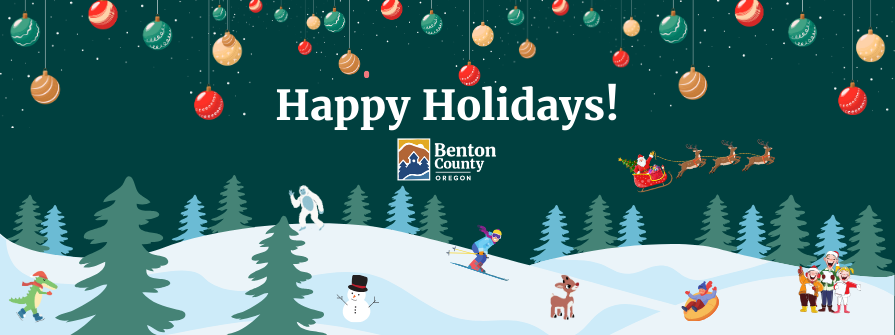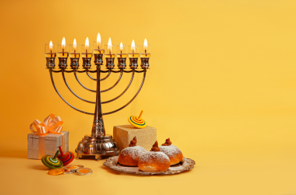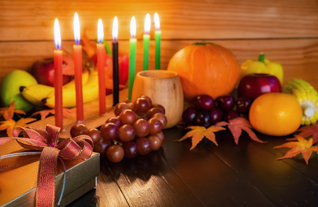Featured celebrations in December…


Hanukkah or Chanukah (Dec. 7-15)
Hanukkah, which translates to “dedication,” started at nightfall December 7th and ends at nightfall on December 15th. This festival is observed for eight days and nights by the lighting of candles with nine branches, commonly known as a menorah or a hanukkiah. Each night a candle is lit with one special candle that is used to light all the other candles – this specific candle is called the shammash. As a candle is lit each night, blessings are recited. It is also customary to play with dreidels which are each marked with a Hebrew letter. Each letter forms the acronym for the phrase “Nes gadol hayah sham,” which means “a great miracle happened here.” Members of the Jewish community celebrate in different ways, but many celebrate by singing songs, eating food made with oil such as donuts or potato pancakes called Latkes, and children will often play with dreidels where the winner receives gold foil wrapped chocolate coins (also known as Hanukkah Gelt).

Las Posadas (Dec. 16-24)
Las Posadas is a religious celebration held for 9 days primarily as a Hispanic Christmas tradition, however, it is not celebrated by every individual in the Hispanic community.
This is most often celebrated in certain Spanish speaking communities in the U.S. and parts of Mexico. This celebration honors the journey made by Joseph and Mary from Bethlehem to Nazareth in search of a place for baby Jesus to be born. The word “posadas” translates to “inn” and honors the journey made by Joseph and Mary in their attempt to seek shelter and safety for the birth of their child, since lodging wasn’t available in Bethlehem.
Sometimes the celebration includes two groups, where one group poses as the host family, and the other group acts as the travelers asking to be let inside for rest and reprieve from their journey. After this, the group playing the “host family” will let the travelers in and offer dinner which traditionally includes tamales, pozole, and other Mexican dishes. In the modern day, variations of these processions are still held. The last home visited is where the procession is allowed in for food and celebrations.

Winter Solstice (Dec. 22)
Communities around the world have celebrated the “sun’s rebirth” during the winter solstice for many, many years. In the Southern Hemisphere, December 22nd marks the summer solstice, while in the Northern Hemisphere it marks the shortest day and longest night of our year. Traditionally, fire and light are often used as symbols to mark the darkest day of the year. While these celebrations have changed over time, it’s something many scholars have noted as a reminder of Indigenous People’s understanding of our complex and intricate solar system. To learn more about the origins of the Winter Solstice and it’s connection to other winter celebrations, click here to watch this video! This video shows Elder Wildfred Buck from the Cree Nation/Tribe share the meaning of the Winter Solstice for his community. “It’s a time for the people to work to replenish their spirit. It’s time for them to dream.”

Christmas (Dec. 25)
Christmas is a widely celebrated Christian festival, however, many consider it a secular holiday which means Christian and non-Christian communities take part in this celebration. Christmas is referred to as Yule in Germanic origins, Navidad in Spanish, Natale in Italian, Noël in French, and Weihnachten in German. While this holiday is typically known as the birth date of Jesus in the religion of Christianity, the precise origin of assigning this date as the birth is unclear. Despite this, Christmas occurs around the same time as the Winter Solstice, and many theologians believe there is some connection between the birth of Jesus and the rebirth of our sun. Christmas has been celebrated for over two millennia and includes spiritual, religious, and worldwide cultural practices. Christmas has also been a federally recognized holiday since 1870. Popular customs from around the world include decorating Christmas trees, exchanging of gifts, sharing meals with loved ones, giving back to each other, baking holiday cookies, Christmas dinner, and celebrating as a community.

Kwanzaa (Dec. 26-Jan. 1)
Kwanzaa translates to “first fruits,” which is derived from the Swahili phrase “mutanda ya kwanzaa.” This special holiday lasts from Dec. 26 to Jan. 1, was first started in 1966 and is not a religious holiday.
Kwanzaa is the celebration of family, community, black culture, knowing and understanding oneself, and the beauty that lies within. This celebration is African-American and African community centered, and is based on the ideas of reconnecting with history and culture, particularly during the time of harvest celebrations.
This holiday largely came out of the attempted erasure of African American’s ancestral roots and culture during their enslavement in our country. The celebration of this beautiful holiday honors the pride and rich cultural history shared by African Americans in our country. There are seven principles of Kwanzaa, which are called Nguzo Saba. These principles are Umoja (Unity), Kujichagulia (Self Determination), Ujimaa (Collective Work), Ujamaa (Cooperative Economics), Nia (Purpose), Kuumba (Creativity), and Imani (Faith). Each principle is highlighted on each day of this celebration, and celebrants are often heard saying “Habi gani?” which means “What’s the word?”
Benton County is an Equal Opportunity-Affirmative Action employer and does not discriminate on the basis of disability in admission or access to our programs, services, activities, hiring and employment practices. This document is available in alternative formats and languages upon request. Please contact Cory Grogan at 541-745-4468 or pioinfo@bentoncountyor.gov.
